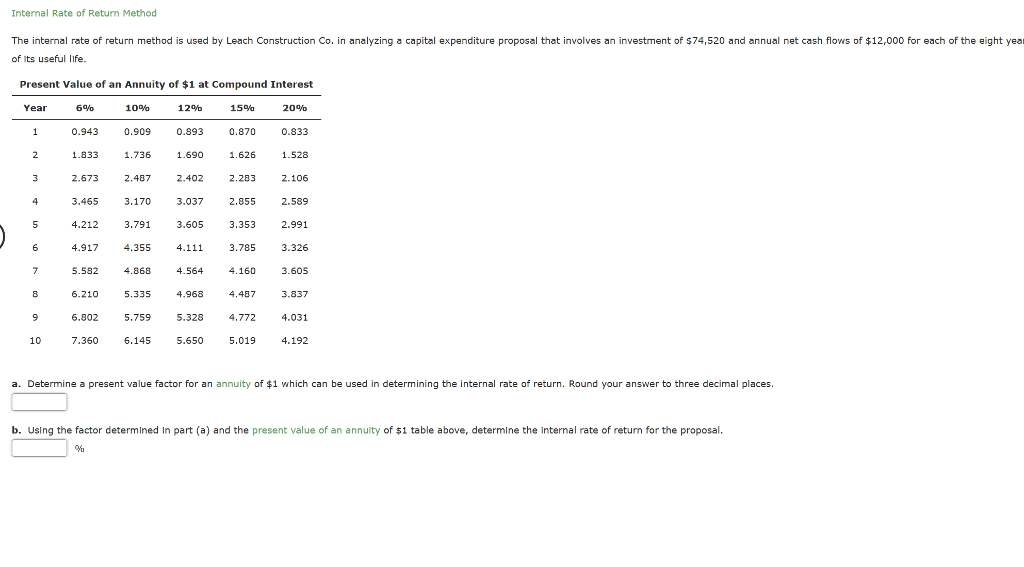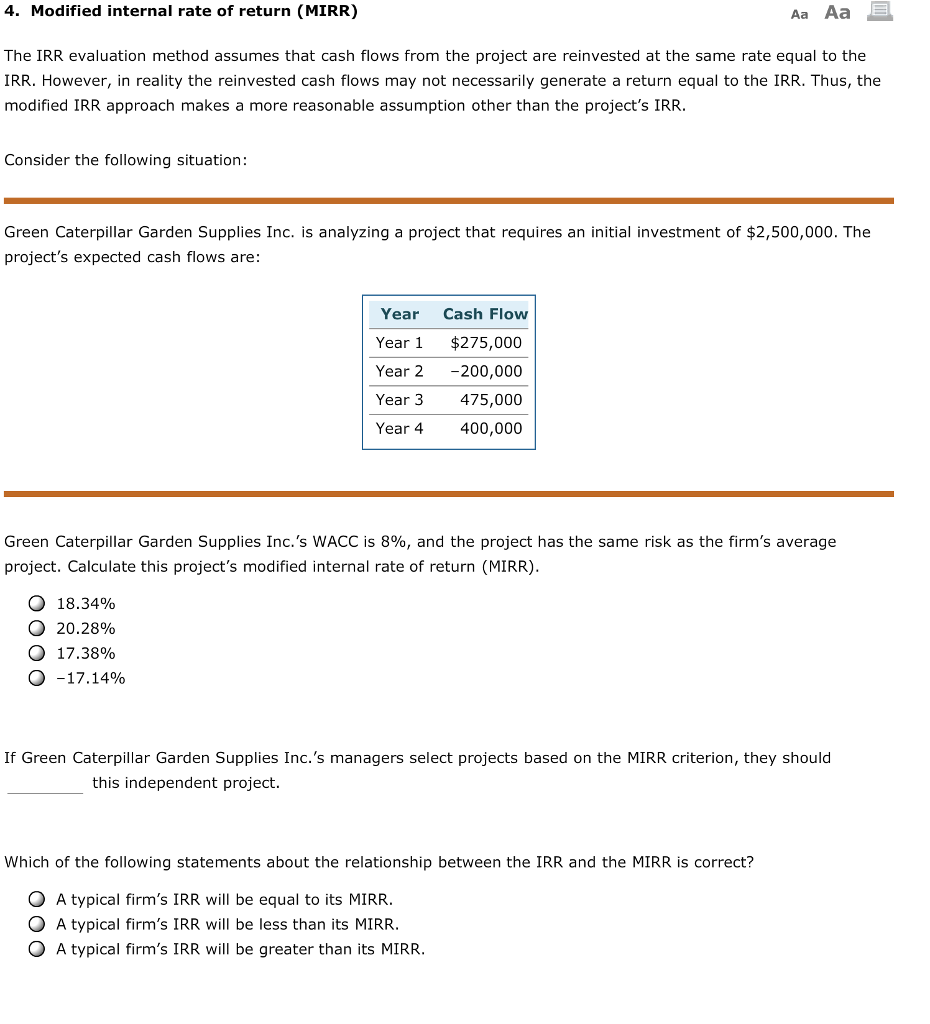
Because the IRR in our example exceeds the discount rate (or required rate of return), the IRR rule says that management should invest in this project. After subtracting the initial investment, the net present value of the project is $545.09, suggesting this is a good investment at the current discount rate. Applied ex-ante, the IRR is an estimate of a future annual rate of return.
How to calculate the IRR
Analyses will also typically involve NPV calculations at different assumed discount rates. We can see that Project A actually has the higher NPV at this point, and therefore Project A would increase the wealth of the shareholders by a greater amount, and should be chosen. So, with mutually exclusive projects, the IRR method can result in the wrong decision being made. If the decision was made purely on IRR, both projects would be ranked the same, and no decision could be made. However, looking at the size of the projects, Project 1 is larger and will generate greater cash flow and therefore profits for the organisation.
A complex calculation
- If there are any irregular or uncommon forms of cash flow, the rule shouldn’t be applied.
- When selecting among several alternative investments, the investor would then select the investment with the highest IRR, provided it is above the investor’s minimum threshold.
- IRR is the discount rate that makes the net present value (NPV) of an investment zero.
- In planning investment projects, firms will often establish a required rate of return (RRR) to determine the minimum acceptable return percentage that the investment in question must earn to be worthwhile.
Therefore, companies use the metric to plan before investing in any project. The hurdle rate or required rate of return is a minimum return expected by an organization on its investment. Any project with an internal rate of return exceeding the hurdle rate is considered profitable. The Excel XIRR function is preferable over the IRR function as it has more flexibility by not being restricted to annual periods. Under XIRR, daily compounding is assumed, and the effective annual rate is returned. But for the IRR function, the interest rate is returned assuming a stream of equally spaced cash flows.
Internal Rate of Return (IRR) Rule: Definition, Formula & Example
In other words, it attains a break-even point where the total cash inflows completely meet the total cash outflow. IRR is generally ideal for use in analyzing capital budgeting projects. It can be misconstrued or misinterpreted if used outside of appropriate scenarios. In the case of positive cash flows followed by negative ones and then by positive ones, the IRR may have multiple values. Moreover, if all cash flows have the same sign (i.e., the project never turns a profit), then no discount rate will produce a zero NPV. IRR, or internal rate of return, is a metric used in financial analysis to estimate the profitability of potential investments.
Ask Any Financial Question
If you know how to calculate IRR, this metric can prove quite helpful. As Daniel Garza, CFA, who manages a research team at registered investment advisor Corient explains, “IRR is often used to determine the feasibility of investment projects.” Given that the company’s cost of capital is 10%, management should proceed with Project A and reject Project B. IRR is also useful for corporations in evaluating stock buyback programs. Because of the nature of the formula, IRR cannot be easily calculated analytically and instead must be calculated iteratively through trial and error or by using software programmed to calculate IRR (e.g., using Excel). Investment decisions shouldn’t be based on XIRR or any other single element.
Get Any Financial Question Answered

Instead, once positive cash flows are reinvested, it’ll be at a rate representing the value of the total capital employed. The internal rate of return (IRR) measures an investment’s profitability, taking into account the time value of money. It’s the discount rate that makes the net present value (NPV) of all cash flows from a particular project equal to zero. In simpler terms, IRR helps investors determine the rate of return they can expect to earn on an investment, considering the timing and size of cash inflows and outflows. The ultimate goal of the IRR is to identify the discount rate that makes the present value of the sum of nominal annual cash inflows equal to the initial net investment outlay.
The alternative formulas, most often taught in academia, involve solving for the IRR for the equation to hold true (and require using a financial calculator). IRR is also useful for corporations in evaluating stock buyback programs. IRR is best individual tax preparation used when comparing investments with similar durations and in tandem with other analyses, such as payback period and net present value (NPV). You can also use CAGR, but IRR will be a better representation of an investment’s performance.
Conversely, a longer project may have a low IRR, earning returns slowly and steadily. The ROI metric can provide some more clarity in these cases, although some managers may not want to wait out the longer time frame. IRR may also be compared against prevailing rates of return in the securities market.
The internal rate of profitability (IRR) is a metric used in financial analysis to estimate the profitability of possible investments. The IRR is a discount rate that makes the net present value (NPV) of all cash flows equal to zero in a discounted cash flow analysis. It must be taken into account that the IRR is not the real dollar value of the project. In general terms, the higher the internal rate of return, the more desirable it is to undertake an investment. The IRR is uniform for investments of different types and, as such, can be used to classify multiple potential investments or projects on a relatively uniform basis.
NPV is the difference between the present value of cash inflows and the present value of cash outflows over time. The estimation is most accurate if one NPV used in the formula is positive and the other one is negative. However, within an exam situation, if a candidate ends up with two positive or two negative NPVs, do not waste time calculating a third. Put the values you have into the formula and complete the calculation; no marks will be lost. Both IRR (internal rate of return) and ROI (return on investment) measure investment performance, but IRR identifies the annual growth rate while ROI reveals the total growth of the investment, from beginning to end. The two numbers should be roughly the same over a one-year period, but not for longer periods of time.